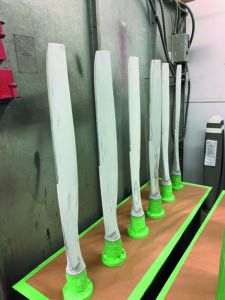It’s enough to make you cringe. You’re taxiing on a paved surface littered with gravel, or even on unpaved surfaces in the outback, with your new sexy composite four-blade and you can almost hear the prop blades’ leading edges getting gouged with stone. Turns out the durability and lifespan of those composite blades are better than you think.
Peter Marshall at MT-Propeller U.S.A. said the nickel-cobalt leading edges on MT composite blades are six times harder than leading edges on aluminum blades. Objects that would have dented or even cracked the blades on traditional propellers would likely bounce off a composite one. This makes them appealing for backcountry ops, where you might not see the kind of blade damage (and limit-wear) you would when slinging a metal prop.
Comparing metal and composite blades from a longevity standpoint under normal conditions, it’s pretty rare that composite blades can’t be brought back to their original dimensions. In the shop, the process is to take off the upper layer of composite material and inspect the core to ensure there’s no damage and then rebuild the blade back to its new specifications. So when those composite blades come out of overhaul, they’re generally identical to factory-new blades. Marshall at MT-Propeller said there is no time limit on MT blades, so many can be operated indefinitely.

Contrast that to metal blades undergoing the overhaul process. These are filed down, causing the airfoil to be just a little bit smaller and perhaps even less efficient, and eventually the metal blades will be beyond service limits. They’ll require replacement—something that you won’t have to worry about with composite blades unless there’s catastrophic damage like a strike. You’ll still have to deal with TBO intervals, of course.
The overhaul process starts much like it does with a metal propeller, with disassembly for a thorough damage inspection. A dye penetrant inspection will be accomplished on the hub, making sure it’s within specs. As for the composite blades, if there are dents and dings on the leading edges, the shop generally replaces them as needed. “Generally what we’re doing is taking off a few upper layers of glass making sure there’s no signs of delamination and cracking and then rebuilding those layers back up to the original dimensions,” MT’s Marshall told us. There’s also the paint process. Don’t underestimate the effort that’s involved to make composite blades as good as new. When we spent a couple of days at Sensenich Propeller Services in Gainesville, Georgia, last year we witnessed a time-consuming process that’s accomplished to extremely tight tolerances.
MT changed its paint a few years ago to the Sherwin Williams Aerospace Coating product, fixing early problems where some composite blades would shed the finish when flying in rain, especially in turbine applications. Field support for composite blades is good, and MT has over 30 shops authorized to work on them. Of course, these days the supply chain bottleneck is also hitting prop shops, although larger shops will have a good supply of exchange blades to shorten downtime during a required overhaul. As for the overhaul cost of a composite prop compared to a metal one, you’ll pay a bit more—as much as 10 percent in some cases. But for some it’s worth it, knowing the blades may never exceed service time limits.
—Larry Anglisano


